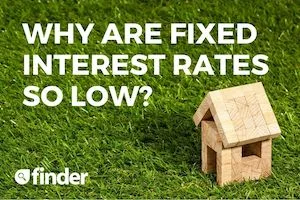
Most of the time, variable rate home loans are lower than fixed rate loans. But in the last few years the opposite has happened, with fixed rate loans becoming the lowest rates on the market.
This has come about because the two loan types are funded differently. Also, when lenders start setting fixed rates lower than variable rates, they're essentially betting that variable rates will remain low for some time.
That's the short answer. But the long answer is more complicated.
The role of the RBA
When the Reserve Bank of Australia (RBA) makes a change to the official cash rate, whether it's an increase or decrease, most home loan customers expect mortgage interest rates to change as well.
In recent years, banks and lenders have been reluctant to cut variable rate home loans in line with RBA rate changes, because their profit margins have been squeezed. However, they have made aggressive cuts to fixed rate home loans.
In fact, an analysis of Finder’s database shows the average standard variable rate has been consistently more expensive than fixed rate loans, from 1- to 5-year fixed rate periods, since the end of 2019.
So what causes fixed rates to become less expensive than variable rates? The answer lies in how these different types of loans are funded.
How fixed rate home loans are funded
Fixed rates are funded by global bond markets. This means banks secure funding by selling debt in overseas markets. Fixed rate loans are generally tied to longer-term debt instruments, which usually carry higher interest rates.
The sophisticated investors who are pricing bond markets are betting about the state of the economy in the future compared to today: whether it will be better or worse.
On the other hand, variable rates are largely pegged to the RBA's official cash rate, which is the amount the Reserve Bank charges banks for overnight loans. The official cash rate currently sits at 0.10%, the lowest it has been in decades.
Fixed rates essentially reflect what the market believes will happen to the official cash rate (and by extension, the standard variable rate) in the future. If the market anticipates that the official cash rate will rise, fixed rates become more expensive, because lenders assume variable rates are likely to rise in the future. If the market believes the official cash rate (and hence variable rates) will fall in the future, fixed rates become less expensive than variable rates.
Finder survey: On average, how long have Australians been on a variable rate for?
| Response | |
|---|---|
| 3-4 yrs | 18.08% |
| Less than 1 year | 17.54% |
| 1-2 yrs | 17% |
| 5-8 yrs | 16.46% |
| 16 yrs or more | 15.91% |
| 9-15 yrs | 15.01% |
Understanding the yield curve
A yield curve is a graph that compares the yield, or interest rate, of particular securities that have the same credit quality, but that mature (or end) on different dates. In other words, a yield curve might compare the yield from a 90-day bank bill to a 10-year bond.
In normal circumstances, the 10-year bond would have a higher yield, which means a yield curve would appear like an upward slope, where the yield rises as the date of maturity lengthens.
However, in some circumstances, longer-term debt instruments become lower-yielding than short-term instruments. This happens when the market assumes that yields, or interest rates, are going to fall in the longer term. When this happens, it’s known as an inverted yield curve.
An inverted yield curve is often cited as a reason for fixed rates falling below variable rates.
It indicates that the market believes rates will be lower in the future than they are now, meaning long-term debt that backs fixed rates becomes cheaper for banks than short-term debt that backs variable rates.
The double-edged sword of an inverted yield curve
When an inverted yield curve occurs, it can represent a good opportunity to fix your loan. It means that fixed rates have become less expensive than variable rates, because banks are able to raise long-term funding for less money than it costs them for short-term funding.
The downside to this is that an inverted yield curve is often the precursor to a recession, which is exactly what happened in Australia in 2020. The inverted yield curve indicates that the bond market is betting that the economy will deteriorate, causing official cash rates to fall. Right now, the official cash rate is just 0.10%, which leaves very little room for the RBA to make any meaningful further cuts.
Australia has seen several inverted yield curves in the past decade:
- The global financial crisis (GFC) was preceded by an inversion of the yield curve between the 90-day bank bill swap rate and 10-year bonds.
- The yield curve inverted once more in 2013, and again in 2018, which preceded fixed rates dropping below variable ones in 2019.
- In 2020, the yield curve inverted to the point where fixed rate loans were up to 0.80% cheaper than variable rate loans.
Should I fix my home loan?
With all of this context, should you choose to fix your home loan interest rate when fixed rates are so much lower than variable rates?
The answer to this depends on your individual circumstances, but a good place to start is working out what your goals and plans are.
When deciding whether to fix your rate or not, don't try to "beat the market", because it rarely works. Instead, consider what your goals are and whether a fixed rate might suit you.
On the plus side, in the current market, a fixed rate loan:
- Is much cheaper than a variable loan. Switching from a variable rate to a fixed one could save you hundreds or even thousands of dollars a month, depending on your loan amount.
- Offers a range of options. There are very cheap fixed rate loans on offer for 1, 2, 3, 4 or 5 years.
- Is available from a range of lenders. It's not just the Big Four banks that are offering competitive deals. A range of smaller banks and non-bank lenders have priced their fixed rate loans very cheaply, and many of these banks have more flexible lending policies that suit a wide range of borrowers.
It's important to also consider the potential risks of a fixed rate loan, and these include:
- Less flexibility. When you lock in to a fixed period, you are committed to repaying your home loan at that rate for that period, with no exceptions. If you decide to move house or wish to sell because, for instance, you've ended a relationship, you are not allowed to end the loan without financial penalty.
- Break fees. Speaking of financial penalty, the break fees can be hefty. In a fixed rate loan, the bank calculates how much profit they "lose" by letting you out of the loan early, and that's how much you have to pay in a break fee. It can be thousands, or even tens of thousands of dollars.
- Overall cost. A five-year fixed rate may look very attractive now when an inverted yield curve causes it to become cheaper than the standard variable rate, but variable rates could become cheaper before the five-year fixed rate period ends.
The best reason to lock in your rate is repayment certainty. When fixed rates become less expensive than variable rates, you can lock in a rate that you know you’ll be comfortable repaying for a set period of time.
And right now, choosing to fix your loan could save you money.
Say you have a loan worth $500,000 and you're paying 2.69% on a variable rate loan. Your home loan repayment currently sits at around $2,025 per month, or $467 per week.
If you fixed your loan at 1.99% for 2 years, your home loan repayment drops to $1,845 per month, or just $426 per week. This is an instant saving of a couple of thousand dollars per year, and you'll have the peace of mind of knowing your repayments will remain the same, regardless of what happens to your bank's standard variable rate or the broader economy.
Sound like a plan? Compare the latest fixed and variable rate home loans below.
Frequently asked questions
More guides on Finder
-
When will rates go down? – Home loan interest rate forecast
What your home loan rate might look like if predictions from the big 4 banks and our economist panel are accurate.
-
Grants and schemes for first home buyers worth $50K-plus
For first home buyers, there’s a range of grants, incentives and programs that could help you into your own home sooner than later.
-
When will interest rates go down?
After 13 interest rate rises from the RBA the rate of inflation is finally slowing. What does this mean for the future of interest rates?
-
Calculate the income needed to buy a home in any suburb in Australia
Work out how much you need to earn to buy a house in any Australian suburb.
-
Average Australian mortgage statistics
Our comprehensive guide to home loan statistics.
-
How to choose a buyer’s agent
In the market for a home or investment? The right buyer's agent could save you thousands. Learn what a buyer's agent does, how much it will cost and more.
-
Compare reverse mortgages in Australia
Compare reverse mortgages and work out if this type of retirement finance is right for you.
-
Investment home loan rates – grab a cheap ticket to landlord town
The best investor home loan rates that have been offered in years have hit the market. Compare investment property loan rates today.
-
Cheap home loans from 5.59% to save & stash cash
Find the cheapest home loan rates and learn how to decide which one best fits your needs and will save you the most money.
-
Best home loans with offset accounts
What is an offset account? It can save you thousands in interest and help you own your home sooner.
Ask a question

Why are the comparison rates on present fixed rates lower than the flat fixed rate itself? That is, when the fees associated with a loan are added to the initial loan rate, the Comparison should be higher, not lower.
Hi Thomas,
In most cases, the comparison rate is higher than the fixed rate when fees are taken into account. However, the comparison rate can be lower. On a fixed rate loan, this is usually because the loan reverts to a lower variable rate after the fixed period ends. Taking that into consideration, the comparison rate ends up being lower.
I hope this helps.
Cheers,
Richard